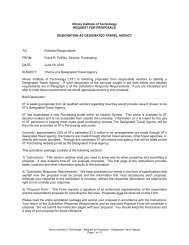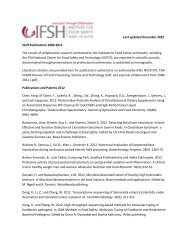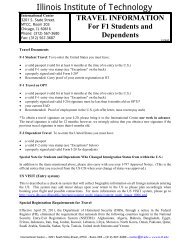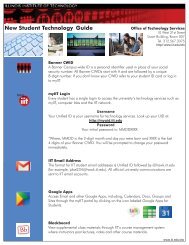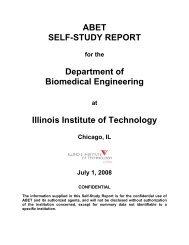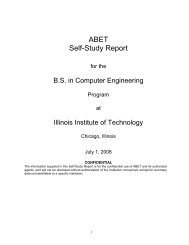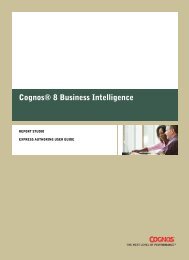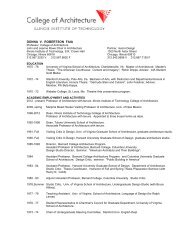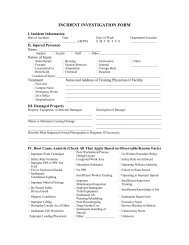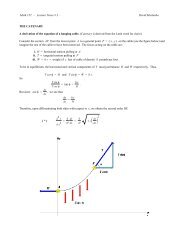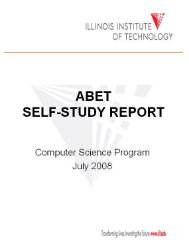Undergraduate Bulletin - Illinois Institute of Technology
Undergraduate Bulletin - Illinois Institute of Technology
Undergraduate Bulletin - Illinois Institute of Technology
You also want an ePaper? Increase the reach of your titles
YUMPU automatically turns print PDFs into web optimized ePapers that Google loves.
Course Descriptions<br />
CS 105<br />
Introduction to Computer Programming<br />
Introduces the use <strong>of</strong> high-level programming language as<br />
a problem-solving tool, including basic data structures and<br />
algorithms, structured programming techniques, and s<strong>of</strong>tware<br />
documentation. Designed for students who have had little or<br />
no prior experience with computer programming.<br />
(2-1-2)<br />
CS 110<br />
Computing Principles<br />
An introduction to the following “big ideas” <strong>of</strong> computer<br />
science: (1) computing is a creative activity; (2) abstraction<br />
reduces information and detail to facilitate focus on relevant<br />
concepts; (3) data and information facilitate the creation <strong>of</strong><br />
knowledge; (4) algorithms are used to develop and express<br />
solutions to computational problems; (5) programming<br />
enables problem solving, human expression, and creation <strong>of</strong><br />
knowledge; (6) the internet pervades modern computing; and<br />
(7) computing has global impacts.<br />
(2-0-2)<br />
CS 115<br />
Object-Oriented Programming I<br />
Introduces the use <strong>of</strong> a high-level object-oriented programming<br />
language as a problem-solving tool, including basic<br />
data structures and algorithms, object-oriented programming<br />
techniques, and s<strong>of</strong>tware documentation. Designed for<br />
students who have had little or no prior experience with<br />
computer programming. For students in CS and CS-related<br />
degree programs.<br />
(2-1-2)<br />
CS 116<br />
Object-Oriented Programming II<br />
Introduces more advanced elements <strong>of</strong> object-oriented programming,<br />
including dynamic data structures, recursion,<br />
searching and sorting, and advanced object-oriented programming<br />
techniques. For students in CS and CS-related<br />
degree programs.<br />
Prerequisite(s): [(CS 115 with min. grade <strong>of</strong> C)]<br />
(2-1-2)<br />
CS 201<br />
Accelerated Introduction to Computer Science<br />
Problem-solving and design using an object-oriented programming<br />
language. Introduces a variety <strong>of</strong> problem-solving<br />
techniques, algorithms, and data structures in object-oriented<br />
programming.<br />
Prerequisite(s): [(CS 105) OR (CS 115)]<br />
(3-2-4)<br />
CS 330<br />
Discrete Structures<br />
Introduction to the use <strong>of</strong> formal mathematical structures<br />
to represent problems and computational processes. Topics<br />
covered include Boolean algebra, first-order logic, recursive<br />
structures, graphs, and abstract language models. Credit will<br />
not be granted for both CS 330 and MATH 230.<br />
Prerequisite(s): [(CS 116) OR (CS 201)]<br />
(3-1-3)<br />
CS 331<br />
Data Structures & Algorithms<br />
Implementation and application <strong>of</strong> the essential data structures<br />
used in computer science. Analysis <strong>of</strong> basic sorting<br />
and searching algorithms and their relationship to these<br />
data structures. Particular emphasis is given to the use <strong>of</strong><br />
object-oriented design and data abstraction in the creation<br />
and application <strong>of</strong> data structures.<br />
Prerequisite(s): [(CS 116) OR (CS 201)]<br />
(3-1-3)<br />
CS 350<br />
Computer Organization & Assembly Language Programming<br />
Introduction to the internal architecture <strong>of</strong> computer systems,<br />
including micro-, mini-, and mainframe computer architectures.<br />
Focuses on the relationship among a computer’s<br />
hardware, its native instruction set, and the implementation<br />
<strong>of</strong> high-level languages on that machine. Uses a set <strong>of</strong><br />
assembly language programming exercises to explore and<br />
analyze a microcomputer architecture. Credit will not be<br />
granted for both CS 350 and ECE 242.<br />
Prerequisite(s): [(CS 116*) OR (CS 201*)] An asterisk (*)<br />
designates a course which may be taken concurrently.<br />
(3-1-3) (C)<br />
CS 351<br />
Systems Programming<br />
Examines the components <strong>of</strong> sophisticated multilayer s<strong>of</strong>tware<br />
systems, including device drivers, systems s<strong>of</strong>tware,<br />
applications interfaces, and user interfaces. Explores the<br />
design and development <strong>of</strong> interrupt-driven and event-driven<br />
s<strong>of</strong>tware.<br />
Prerequisite(s): [(CS 331 and CS 350) OR (CS 331 and ECE<br />
242)]<br />
(3-1-3)<br />
CS 397<br />
Special Projects<br />
(Credit: Variable)<br />
CS 411<br />
Computer Graphics<br />
Overview <strong>of</strong> display devices and applications. Vector graphics<br />
in two and three dimensions. Image generation, representation,<br />
and manipulation. Homogeneous coordinates. Modeling<br />
and hidden line elimination. Introduction to raster graphics.<br />
Perspective and parallel projections.<br />
Prerequisite(s): [(CS 331) OR (CS 401) OR (CS 403)]<br />
(3-0-3) (T)<br />
CS 422<br />
Data Mining<br />
This course will provide an introductory look at concepts<br />
and techniques in the field <strong>of</strong> data mining. After covering<br />
the introduction and terminologies to Data Mining, the<br />
techniques used to explore the large quantities <strong>of</strong> data for<br />
the discovery <strong>of</strong> meaningful rules and knowledge such as<br />
market basket analysis, nearest neighbor, decision trees, and<br />
clustering are covered. The students learn the material by<br />
implementing different techniques throughout the semester.<br />
Prerequisite(s): [(CS 331) OR (CS 401) OR (CS 403)]<br />
(3-0-3) (C)(T)<br />
CS 425<br />
Database Organization<br />
Overview <strong>of</strong> database architectures, including the Relational,<br />
Hierarchical, Network, and Object Models. Database interfaces,<br />
including the SQL query language. Database design<br />
using the Entity-Relationship Model. Issues such as security,<br />
integrity, and query optimization.<br />
Prerequisite(s): [(CS 331) OR (CS 401) OR (CS 403)]<br />
(3-0-3) (C)(T)<br />
210



